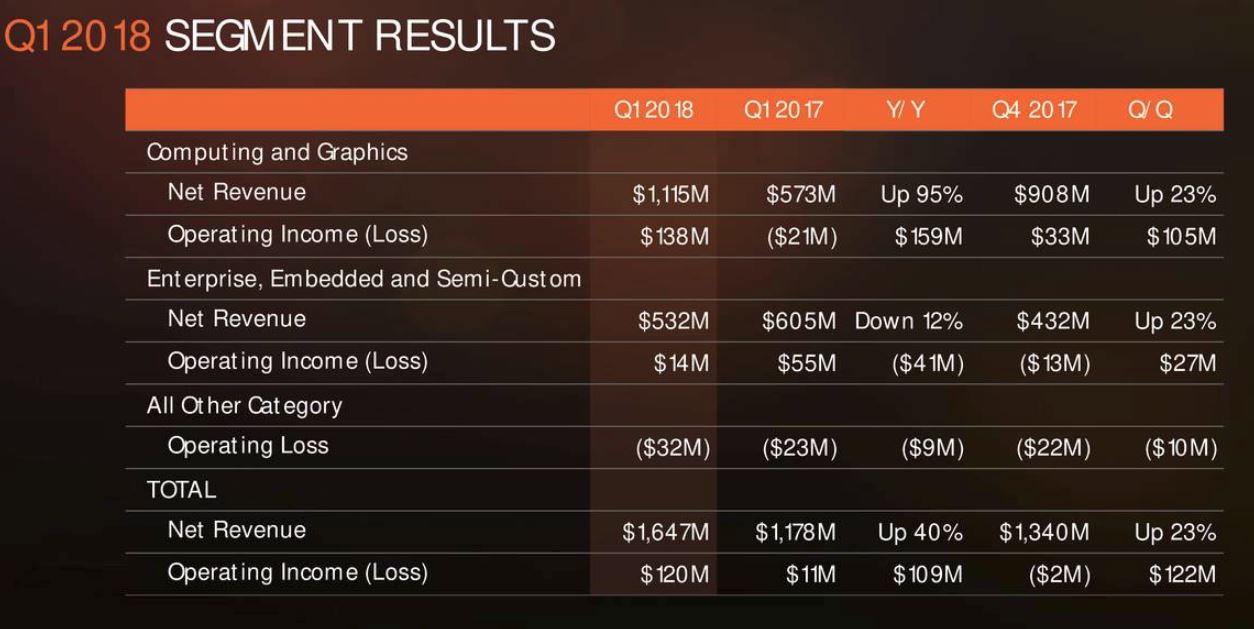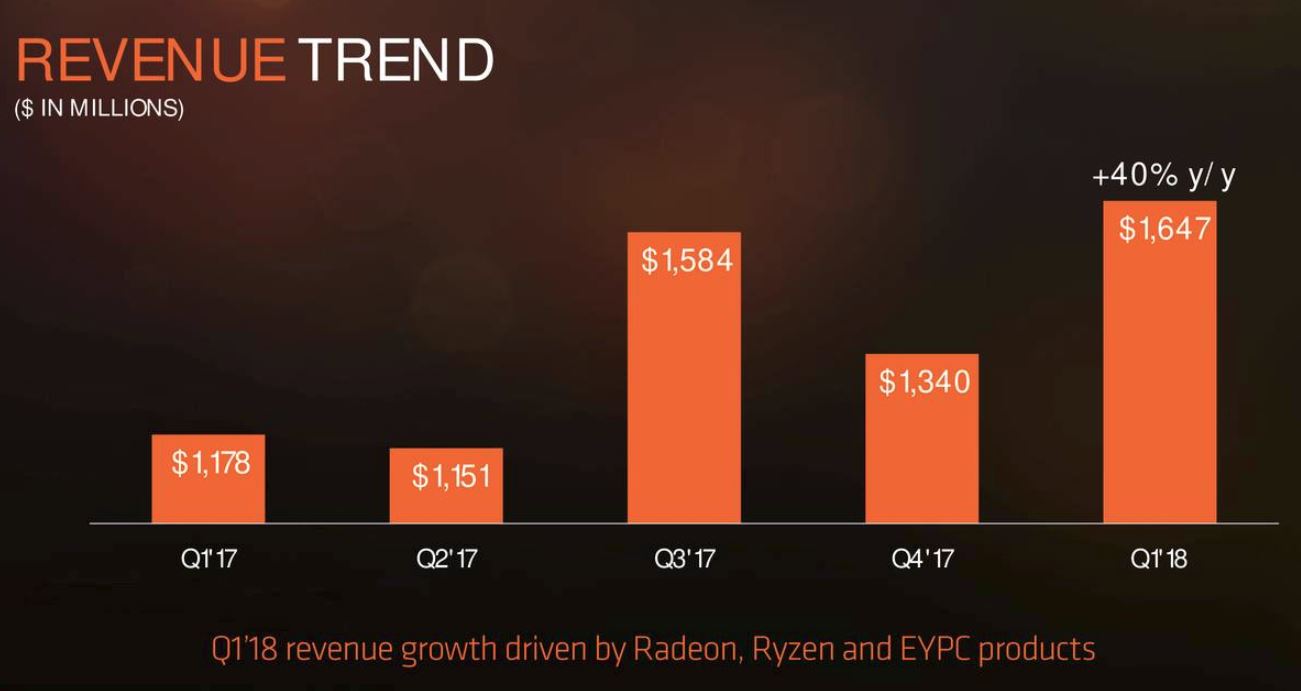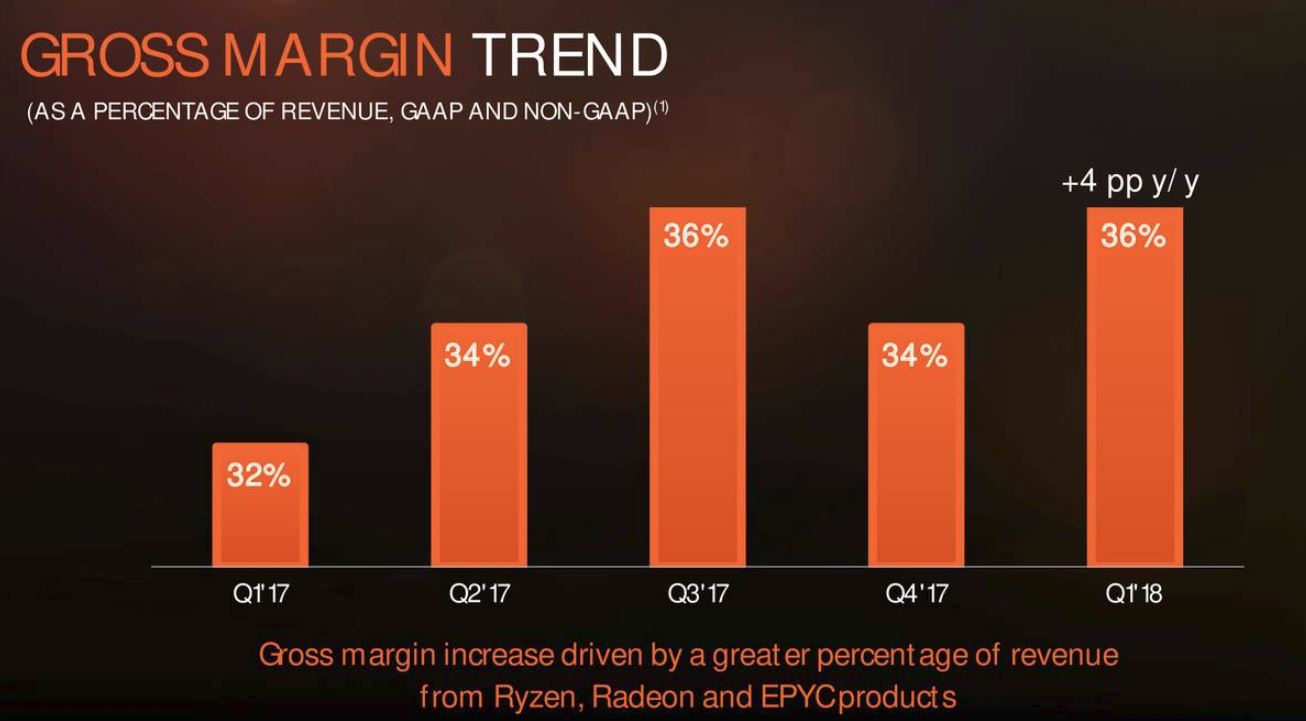AMD Earnings Soar on Exploding Ryzen Growth, Crypto Mining Craze
AMD's Q1 2018 financial report is impressive in almost every respect. Quarterly revenue increased 40% year-over-year to a healthy $1.65 billion, marking the third consecutive quarter of double-digit revenue growth. The growth is largely driven by Ryzen and Radeon chip sales that contributed to $81 million in profit during the quarter. That's a nice improvement over the $31 million loss in the same quarter last year.
Better yet, AMD is forecasting 50% YoY revenue growth for the next quarter and 20% revenue growth for the year, which suggests the company is just hitting its stride. The company is also busy plotting a course for the future: it already has 7nm GPUs in its labs fabbed on TSMC's silicon and 7nm EPYC 2 processors in development.
AMD lumps its computing (CPU) and graphics revenue together in its financial reporting, and that crucial segment is up 95% on the year. That is undoubtedly coming at the expense of some of Intel's market share.
AMD says that Ryzen processors made up 60% of its product mix in Q1, which is a pronounced 20% jump over the previous quarter. It's notable that AMD's new second-generation Ryzen processors weren't shipping during the quarter, so we can expect that mix to increase further. AMD also cited strong Ryzen Mobile sales as a contributing factor. The company is also rolling out its Ryzen Pro models soon, which will debut in Dell, HP, and Lenovo laptops, among others.
AMD CEO Lisa Su revealed that the company has working 7nm GPU silicon in its labs, which we know from its pre-CES announcements is a Radeon Instinct MI25 card with the Vega architecture. AMD says the 7nm GPUs and 7nm EPYC 2 processors are on schedule to sample to customers by the end of the year. Both 7nm products will ship in volume in early 2019.
Su also disclosed that the company is using TSMC for its leading-edge 7nm graphics cards, while the company will use GlobalFoundries for other unspecified 7nm products. The TSMC deal is surprising because AMD inked a five-year Wafer Supply Agreement (WSA) with GlobalFoundries that extends through the 7nm era. The WSA ties AMD into wafer purchase targets and requires the AMD to pay an offset fee to GlobalFoundries for any wafers it procures from other fabs. Su noted that AMD is not concerned about being able to secure enough 7nm production capacity from TSMC.
Su disclosed that the AMD predicts cryptocurrencies/blockchain comprised 10% of the company's quarterly gross revenue. Investors have been skittish about the impact of cryptocurrency demand on both AMD and Nvidia's earnings, largely because both companies boosted production during the last crypto mining boom and then faced massive oversupplies as the craze receded. AMD expects the crypto demand to recede in the coming quarter as the boom wanes. The company projects that blockchain will comprise a "mid-to-high single digit" percentage of the company's revenue this year.
Get Tom's Hardware's best news and in-depth reviews, straight to your inbox.
AMD caters to commercial miners, but Su said that allocating graphics cards to gamers is the company's first priority. In the last earnings call, AMD announced that it had boosted GPU production to meet demand. That's a risky proposition when the volatile mining market drives demand.
Su cited several reasons why this mining cycle is different from the previous boom, which include pent-up demand from gamers that haven't purchased graphics cards due to high pricing. The last mining crash also came when Bitcoin was the only real viable cryptocurrency, whereas this cycle includes a proliferation of alt-coins that miners can switch to as some coins crash. Su also mentioned that most miners use graphics cards for multiple purposes, such as gaming for enthusiasts and cloud applications for commercial users, which could prevent a sudden flood of second-hand cards that drive down prices and reduce demand. AMD also says that growing CPU sales would help offset any declines in GPU revenue.



AMD's Enterprise, Embedded and Semi-Custom (EESC) segment revenue weighed in at $532 million, which is down 12% YoY. This is due to weakness in the console market, but it was partially offset by EPYC server processor sales, which doubled over the previous quarter. OEM design wins have driven much of this growth, with Dell/EMC and Cray being among the most recent additions. Overall, AMD expects to capture a "mid-single digit" percentage of server market share this year, which is on track with earlier projections. This should accelerate when 7nm EPYC debuts in early 2019.
AMD's stock is up 10% in after-hours trading. Given its projection of $1.275 billion in revenue next quarter, it will likely continue to rise. AMD also plowed $343 million into R&D during Q1, which is a marked increase over the $266 million it invested in the previous quarter. That should help ensure the company continues to see more impressive growth over the quarters to come. Su also teased that the company has pending IP-related revenue coming in future quarters, which could be the fruits of the company's patent licensing to Chinese fabs through the THATIC agreement, or the rumored deal with Tesla.
AMD's Ryzen processors are clearly gaining more market share, which is impressive because the company recently told us that it had captured up to 50% of CPU sales to DIYers on sites like Newegg and Amazon. Intel's recent earnings call exposed a 5% decline in its desktop CPU sales, which may have worsened in the interim. Intel's earnings call is tomorrow, so stay tuned for the details.

Paul Alcorn is the Editor-in-Chief for Tom's Hardware US. He also writes news and reviews on CPUs, storage, and enterprise hardware.
-
bit_user On Newegg, 8 GB RX 580's are going for as little as $350. 4 GB RX 560's for $150 ($135 after rebate).Reply
The Vega's still command a bigger premium, but you can get a GTX 1080 for about $600. We're getting there (and this pricing has held for at least a couple weeks).
Now, if the RAM prices would do the same... -
mihen In a period when AMD literally cannot produce enough chips, they are still not able to eclipse nVidia's revenue including CPU sales.Reply -
bit_user Reply
Look at the margins, though. Nvidia is selling V100's for nearly $10k each! It's all because Volta sits unopposed.20917833 said:In a period when AMD literally cannot produce enough chips, they are still not able to eclipse nVidia's revenue including CPU sales. -
InvalidError 7nm EPYC sampling to customers by the end of the year, shipping early next... sounds like everything is still on track for significant 7nm launches in 2019. Intel might fall behind.Reply -
ml.imaging This is wonderful news for everyone interested in PC building. Now if AMD could offer AMD compatible RAM bundles with their CPUs this would make for additional profits for AMD and savings for us also. (:>)Reply
Rehards.
Mike -
Kahless01 id like to add buy a new ryzen from them soon. but them being viable again can only help all of us. hopefully they get big enough that they can grow again in austin and a bunch of good paying jobs open up. they all but closed down here.Reply -
JamesSneed Reply20918496 said:7nm EPYC sampling to customers by the end of the year, shipping early next... sounds like everything is still on track for significant 7nm launches in 2019. Intel might fall behind.
Yeah that is very exciting news. This is the end game for Zen's design as it is supposed to resolve the lower obtainable frequencies vs Intel chips on top of its 7nm so better densities etc. This is going to be huge deal if they can stay on target as they will be ramping up 7nm right around the time Intel's 10nm ramps up. -
cryoburner Reply
Graphics card prices have certainly been improving, but I'm not sure I would consider $350 for an RX 580 as being particularly good. The 8GB version launched for $229, and the 4GB version for $199, so we're still looking at prices more than $100 over MSRP for those cards. The prices are thankfully trending downward at least, and they will hopefully come close to where they were a year ago in the coming months.20917760 said:On Newegg, 8 GB RX 580's are going for as little as $350...
And while RAM prices are high, it's still possible for someone to make do with 8GB and get good performance in the vast majority of existing games and applications. If anything, RAM prices back in 2016 were abnormally low. Sure, you could get 16GB of relatively fast DDR4 for around $70, but most people didn't actually need that much. I'm sure there are lots of people who put more RAM than necessary in their system at that time, and still haven't even touched more than half of it. I can't help but think that if pricing hadn't been lowered so much at that time, supplies might have been better now. -
InvalidError Reply
I have 32GB of RAM and most of it is always in use, ~15GB specifically allocated to the boatload of software I have open most of the time and the rest to the file system cache so software rarely needs to reload stuff from HDD after the first time. If you count file system cache as use of RAM, 16GB is a very reasonable amount to have for comfort and most people with 16GB are likely using most of it. I know playing WoW and most other games without enough RAM to keep all of the frequently used world data cached is a patience-sapping exercise when running from HDD. Non-issue with enough RAM to cache the thing.20920640 said:I'm sure there are lots of people who put more RAM than necessary in their system at that time, and still haven't even touched more than half of it.

